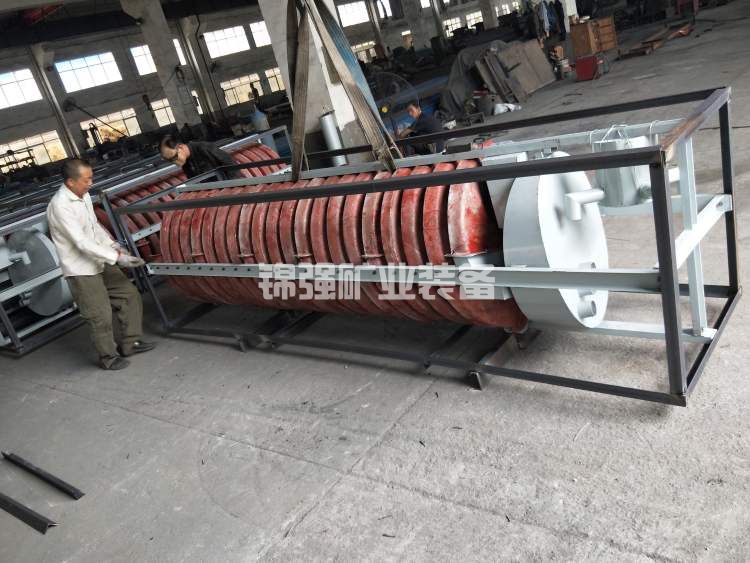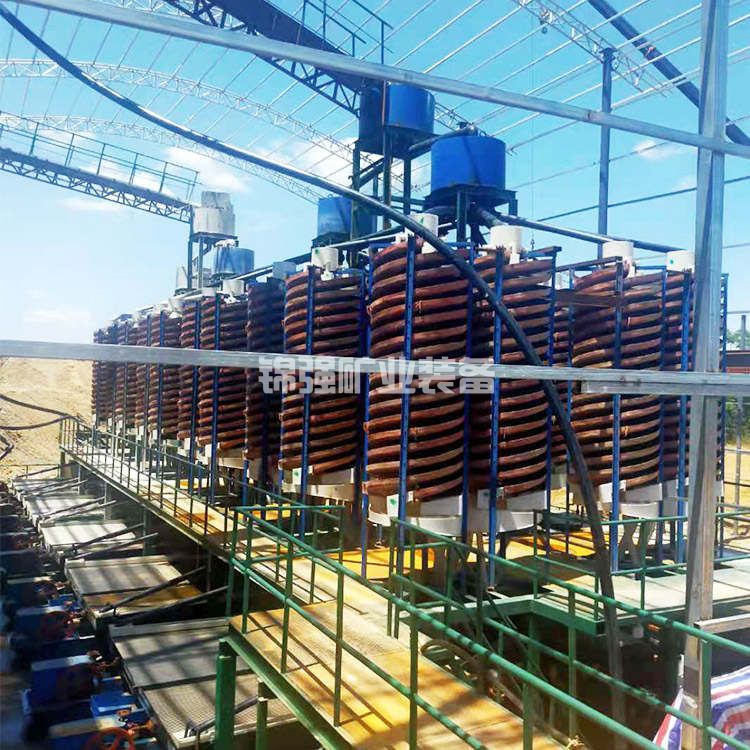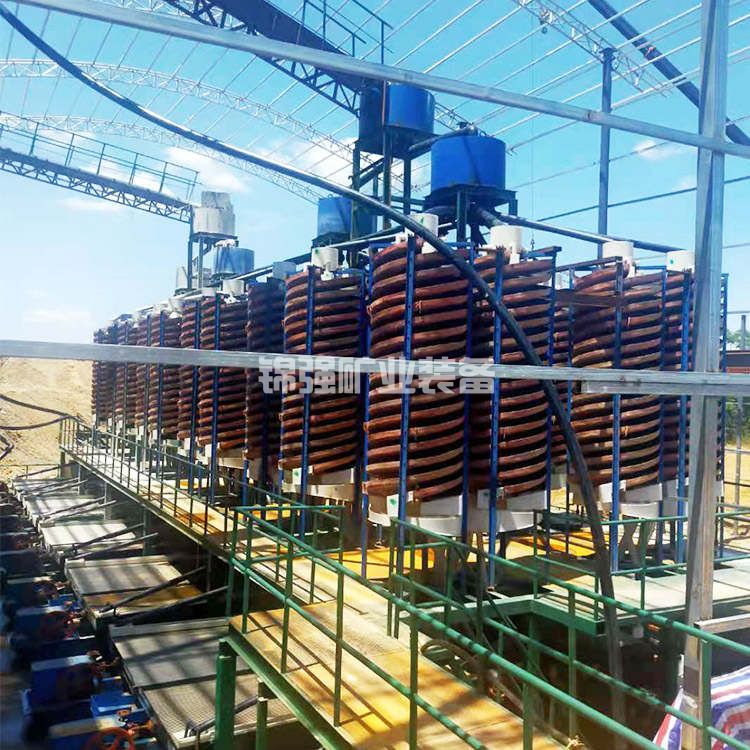 Service Phone:
+8619870423316
Service Phone:
+8619870423316
 Service Phone:+8619870423316
Service Phone:+8619870423316
current location: home > News and information > Reselection of knowledge
update date :2023-07-26 15:39:52Number of views: author:huang
Experimental spiral chute 1. Product introduction. A gravity separation equipment that uses the inertial centrifugal force generated by mortar in spiral motion to achieve the separation of light and heavy minerals. 2、 How to apply. Erect the fiberglass chute, align it with the vertical line, use an iron frame or wood to stabilize it in a suitable direction, and use a sand pump to deliver the mineral sand to the top two ore inlet points of the spiral. This increases water and adjusts the density of the mineral sand slurry. The mineral slurry naturally swirls from top to bottom, and an inertial centrifugal force occurs in the rotating inclined flow velocity. The difference in the gravity, particle size, and shape of the sand ore is affected by the gravity obtained from the swirling flow and this centrifugal force, Separating the ore from the sand, the concentrate enters the beneficiation hopper and is piped out, while the tailings enter the tailings hopper and are piped to the sand tank, which is then discharged by a mortar pump, completing the entire beneficiation process. The spiral chute used in the experiment at  is characterized by three aspects. Due to low power consumption, simple structure, small area occupied, simple operation, stable beneficiation, clear ore separation, no need for moving parts, convenient Computerized maintenance management system, large processing output per unit size and other characteristics, FRP chutes have attracted much attention in many gravity beneficiation equipment. The machinery has a relatively wide and gentle groove surface, and the slurry flows in a laminar flow with a larger area, making it more suitable for processing medium to fine (-4mm) ore particles. We have made spiral chutes with diameters of 400, 600, 900, and 1200mm domestically, Ф The processing capacity of 1200MM four head is about 4-6 t/h. Experimental spiral chute
is characterized by three aspects. Due to low power consumption, simple structure, small area occupied, simple operation, stable beneficiation, clear ore separation, no need for moving parts, convenient Computerized maintenance management system, large processing output per unit size and other characteristics, FRP chutes have attracted much attention in many gravity beneficiation equipment. The machinery has a relatively wide and gentle groove surface, and the slurry flows in a laminar flow with a larger area, making it more suitable for processing medium to fine (-4mm) ore particles. We have made spiral chutes with diameters of 400, 600, 900, and 1200mm domestically, Ф The processing capacity of 1200MM four head is about 4-6 t/h. Experimental spiral chute  4. Construction of spiral chute Note that the experimental spiral chute made of fiberglass spiral chute is composed of six parts: feeding homogenizer, feeding chute, spiral groove, product acquisition groove, equipment gathering bucket, and groove support (including cross or triangular frame). The rotating groove formed by connecting rotating pieces is the main component. The spiral plate is made of fiberglass (fiberglass reinforced coal gangue) and connected together through screws. The sorting surface of the spiral groove has a pre made durable and wear-resistant layer. It also has the advantages of lightweight, solid, and durable consumables. The head of the rotating groove is equipped with a multi tube feeding homogenizer for ore dressing, which is simple and convenient to control. The sorting machine does not need to be placed on the cross (or tripod) of the support table to restrict stacking. The uniform mineral mortar is slowly fed onto the surface of the rotating groove through the feeding groove installed at the end of the spiral groove head for selection. The tail of the spiral groove is installed in a valve type new product selection groove, allowing the sorted new products to be divided into three types (or four types) of new equipment along the radial direction according to grade. Change the cutting width of each new product by adjusting the orientation of the valve block. The new product agglomeration bucket is a concentric circular tube that leads to the differential aggregation of selected multi-directional mineral flows. The cross section of the fiberglass chute has different slopes, which is very suitable for the selection of fine particle mineral materials. 5、 Application: This machine is used to separate 0.3-0.02mm fine materials to obtain iron, ferrotitanium, ferrochrome, ferrosulfide, zircon ore, Rutile ore, monazite ore, phosphorus, wolframite, tin ore, tantalum niobium, niobium ore and other non-ferrous metal ores, rare mineral metals and non-metallic minerals with gravity difference. Experimental spiral chute
4. Construction of spiral chute Note that the experimental spiral chute made of fiberglass spiral chute is composed of six parts: feeding homogenizer, feeding chute, spiral groove, product acquisition groove, equipment gathering bucket, and groove support (including cross or triangular frame). The rotating groove formed by connecting rotating pieces is the main component. The spiral plate is made of fiberglass (fiberglass reinforced coal gangue) and connected together through screws. The sorting surface of the spiral groove has a pre made durable and wear-resistant layer. It also has the advantages of lightweight, solid, and durable consumables. The head of the rotating groove is equipped with a multi tube feeding homogenizer for ore dressing, which is simple and convenient to control. The sorting machine does not need to be placed on the cross (or tripod) of the support table to restrict stacking. The uniform mineral mortar is slowly fed onto the surface of the rotating groove through the feeding groove installed at the end of the spiral groove head for selection. The tail of the spiral groove is installed in a valve type new product selection groove, allowing the sorted new products to be divided into three types (or four types) of new equipment along the radial direction according to grade. Change the cutting width of each new product by adjusting the orientation of the valve block. The new product agglomeration bucket is a concentric circular tube that leads to the differential aggregation of selected multi-directional mineral flows. The cross section of the fiberglass chute has different slopes, which is very suitable for the selection of fine particle mineral materials. 5、 Application: This machine is used to separate 0.3-0.02mm fine materials to obtain iron, ferrotitanium, ferrochrome, ferrosulfide, zircon ore, Rutile ore, monazite ore, phosphorus, wolframite, tin ore, tantalum niobium, niobium ore and other non-ferrous metal ores, rare mineral metals and non-metallic minerals with gravity difference. Experimental spiral chute  Experimental spiral chute
Experimental spiral chute
 what type of mining was used to find gol
what type of mining was used to find gol tin mining equipment
tin mining equipment Design of Spiral Chute Beneficiation
Design of Spiral Chute Beneficiation Jiangxi fiberglass spiral chute quotatio
Jiangxi fiberglass spiral chute quotatio Rough selection of sandy kaolin spiral c
Rough selection of sandy kaolin spiral c Formula for processing capacity of spira
Formula for processing capacity of spira Coal slime gold mine spiral chute
Coal slime gold mine spiral chute 38 degree complete spiral chute
38 degree complete spiral chute Installation process of spiral chute
Installation process of spiral chute Spiral chute energy-saving installation
Spiral chute energy-saving installation Particle size of iron ore spiral chute
Particle size of iron ore spiral chute Manufacturing method of anti crushing sp
Manufacturing method of anti crushing sp